Tort Law: Establishing Negligence and Defense of Volenti Non Fit Injuria
VerifiedAdded on 2023/01/23
|9
|2482
|62
AI Summary
This document discusses the elements of establishing a case of negligence in Tort Law, including duty of care, breach of duty, actual loss or damage, foreseeability, proximity in relationship, and fairness. It also explores the defense of Volenti Non Fit Injuria and its essential elements. The case of Anita and Benjamin is used as an example to illustrate these concepts.
Contribute Materials
Your contribution can guide someone’s learning journey. Share your
documents today.
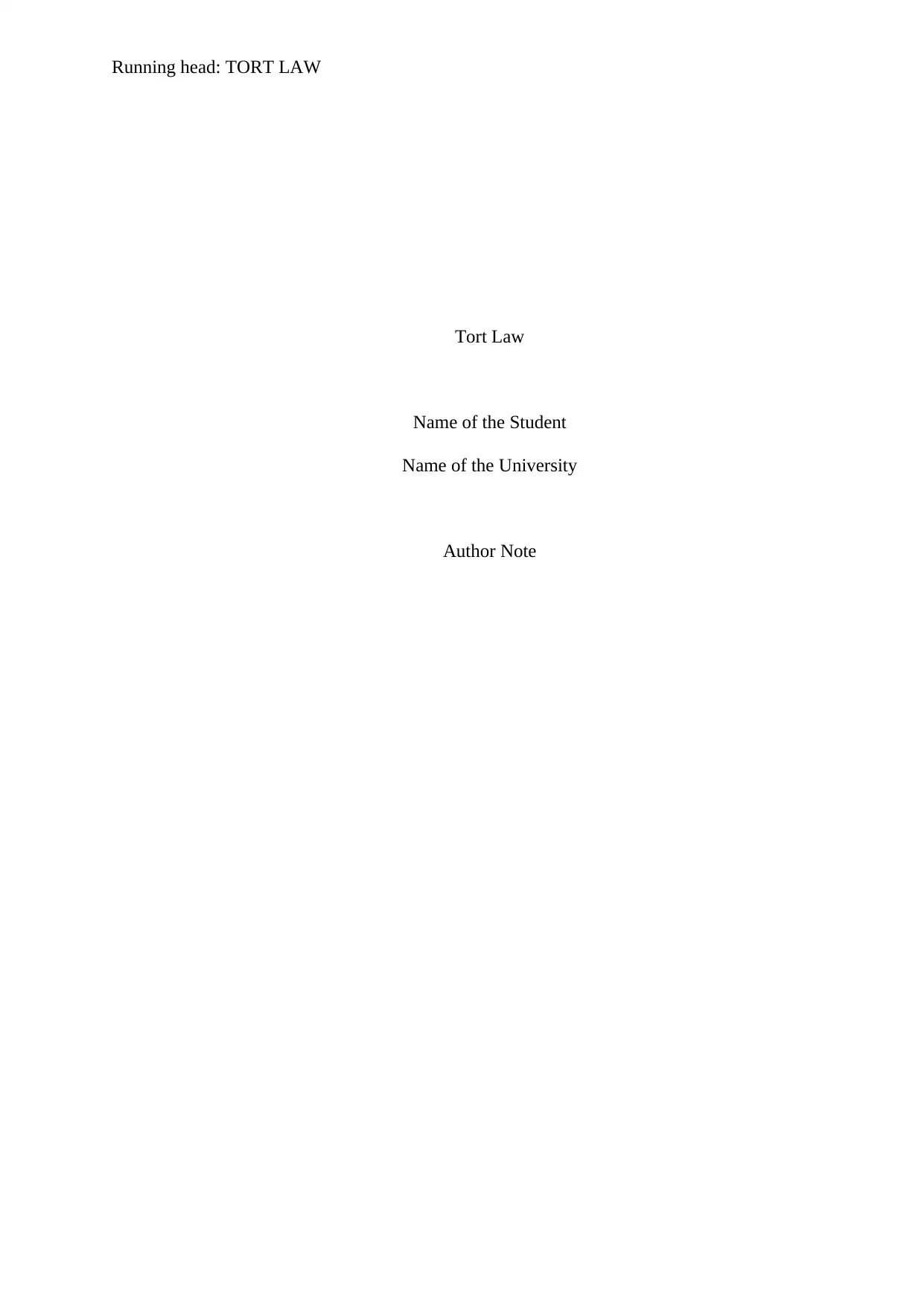
Running head: TORT LAW
Tort Law
Name of the Student
Name of the University
Author Note
Tort Law
Name of the Student
Name of the University
Author Note
Secure Best Marks with AI Grader
Need help grading? Try our AI Grader for instant feedback on your assignments.
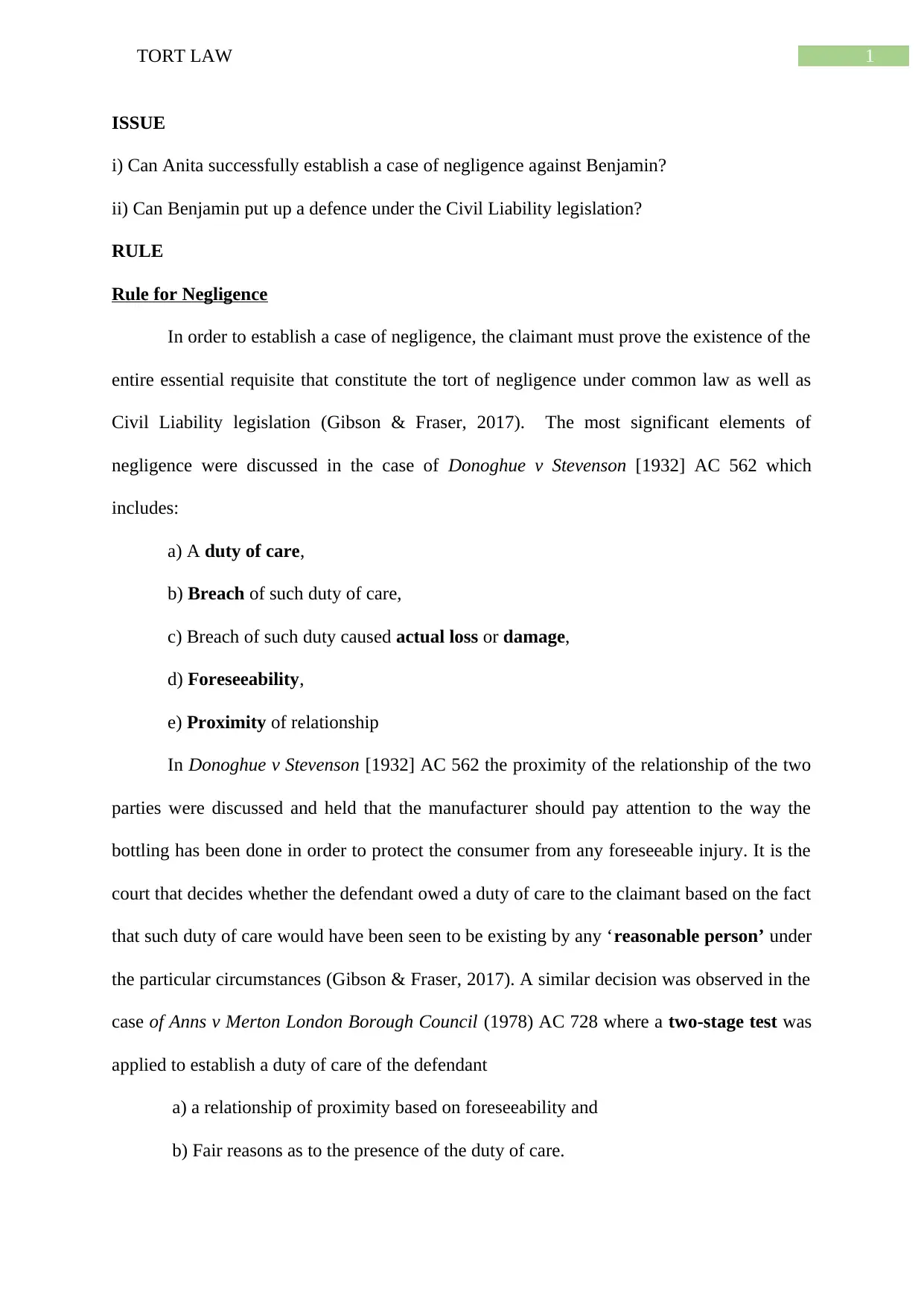
1TORT LAW
ISSUE
i) Can Anita successfully establish a case of negligence against Benjamin?
ii) Can Benjamin put up a defence under the Civil Liability legislation?
RULE
Rule for Negligence
In order to establish a case of negligence, the claimant must prove the existence of the
entire essential requisite that constitute the tort of negligence under common law as well as
Civil Liability legislation (Gibson & Fraser, 2017). The most significant elements of
negligence were discussed in the case of Donoghue v Stevenson [1932] AC 562 which
includes:
a) A duty of care,
b) Breach of such duty of care,
c) Breach of such duty caused actual loss or damage,
d) Foreseeability,
e) Proximity of relationship
In Donoghue v Stevenson [1932] AC 562 the proximity of the relationship of the two
parties were discussed and held that the manufacturer should pay attention to the way the
bottling has been done in order to protect the consumer from any foreseeable injury. It is the
court that decides whether the defendant owed a duty of care to the claimant based on the fact
that such duty of care would have been seen to be existing by any ‘reasonable person’ under
the particular circumstances (Gibson & Fraser, 2017). A similar decision was observed in the
case of Anns v Merton London Borough Council (1978) AC 728 where a two-stage test was
applied to establish a duty of care of the defendant
a) a relationship of proximity based on foreseeability and
b) Fair reasons as to the presence of the duty of care.
ISSUE
i) Can Anita successfully establish a case of negligence against Benjamin?
ii) Can Benjamin put up a defence under the Civil Liability legislation?
RULE
Rule for Negligence
In order to establish a case of negligence, the claimant must prove the existence of the
entire essential requisite that constitute the tort of negligence under common law as well as
Civil Liability legislation (Gibson & Fraser, 2017). The most significant elements of
negligence were discussed in the case of Donoghue v Stevenson [1932] AC 562 which
includes:
a) A duty of care,
b) Breach of such duty of care,
c) Breach of such duty caused actual loss or damage,
d) Foreseeability,
e) Proximity of relationship
In Donoghue v Stevenson [1932] AC 562 the proximity of the relationship of the two
parties were discussed and held that the manufacturer should pay attention to the way the
bottling has been done in order to protect the consumer from any foreseeable injury. It is the
court that decides whether the defendant owed a duty of care to the claimant based on the fact
that such duty of care would have been seen to be existing by any ‘reasonable person’ under
the particular circumstances (Gibson & Fraser, 2017). A similar decision was observed in the
case of Anns v Merton London Borough Council (1978) AC 728 where a two-stage test was
applied to establish a duty of care of the defendant
a) a relationship of proximity based on foreseeability and
b) Fair reasons as to the presence of the duty of care.
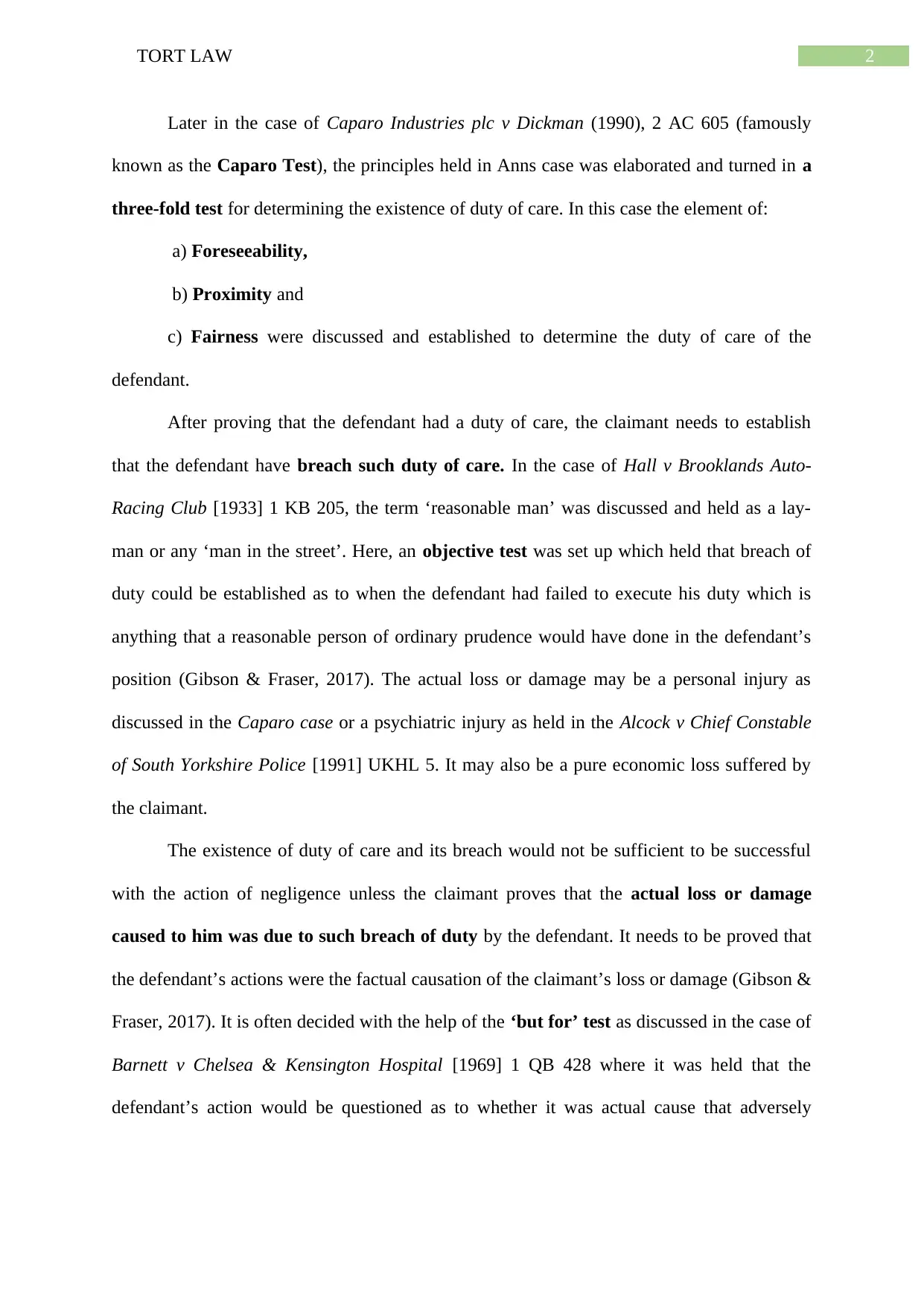
2TORT LAW
Later in the case of Caparo Industries plc v Dickman (1990), 2 AC 605 (famously
known as the Caparo Test), the principles held in Anns case was elaborated and turned in a
three-fold test for determining the existence of duty of care. In this case the element of:
a) Foreseeability,
b) Proximity and
c) Fairness were discussed and established to determine the duty of care of the
defendant.
After proving that the defendant had a duty of care, the claimant needs to establish
that the defendant have breach such duty of care. In the case of Hall v Brooklands Auto-
Racing Club [1933] 1 KB 205, the term ‘reasonable man’ was discussed and held as a lay-
man or any ‘man in the street’. Here, an objective test was set up which held that breach of
duty could be established as to when the defendant had failed to execute his duty which is
anything that a reasonable person of ordinary prudence would have done in the defendant’s
position (Gibson & Fraser, 2017). The actual loss or damage may be a personal injury as
discussed in the Caparo case or a psychiatric injury as held in the Alcock v Chief Constable
of South Yorkshire Police [1991] UKHL 5. It may also be a pure economic loss suffered by
the claimant.
The existence of duty of care and its breach would not be sufficient to be successful
with the action of negligence unless the claimant proves that the actual loss or damage
caused to him was due to such breach of duty by the defendant. It needs to be proved that
the defendant’s actions were the factual causation of the claimant’s loss or damage (Gibson &
Fraser, 2017). It is often decided with the help of the ‘but for’ test as discussed in the case of
Barnett v Chelsea & Kensington Hospital [1969] 1 QB 428 where it was held that the
defendant’s action would be questioned as to whether it was actual cause that adversely
Later in the case of Caparo Industries plc v Dickman (1990), 2 AC 605 (famously
known as the Caparo Test), the principles held in Anns case was elaborated and turned in a
three-fold test for determining the existence of duty of care. In this case the element of:
a) Foreseeability,
b) Proximity and
c) Fairness were discussed and established to determine the duty of care of the
defendant.
After proving that the defendant had a duty of care, the claimant needs to establish
that the defendant have breach such duty of care. In the case of Hall v Brooklands Auto-
Racing Club [1933] 1 KB 205, the term ‘reasonable man’ was discussed and held as a lay-
man or any ‘man in the street’. Here, an objective test was set up which held that breach of
duty could be established as to when the defendant had failed to execute his duty which is
anything that a reasonable person of ordinary prudence would have done in the defendant’s
position (Gibson & Fraser, 2017). The actual loss or damage may be a personal injury as
discussed in the Caparo case or a psychiatric injury as held in the Alcock v Chief Constable
of South Yorkshire Police [1991] UKHL 5. It may also be a pure economic loss suffered by
the claimant.
The existence of duty of care and its breach would not be sufficient to be successful
with the action of negligence unless the claimant proves that the actual loss or damage
caused to him was due to such breach of duty by the defendant. It needs to be proved that
the defendant’s actions were the factual causation of the claimant’s loss or damage (Gibson &
Fraser, 2017). It is often decided with the help of the ‘but for’ test as discussed in the case of
Barnett v Chelsea & Kensington Hospital [1969] 1 QB 428 where it was held that the
defendant’s action would be questioned as to whether it was actual cause that adversely
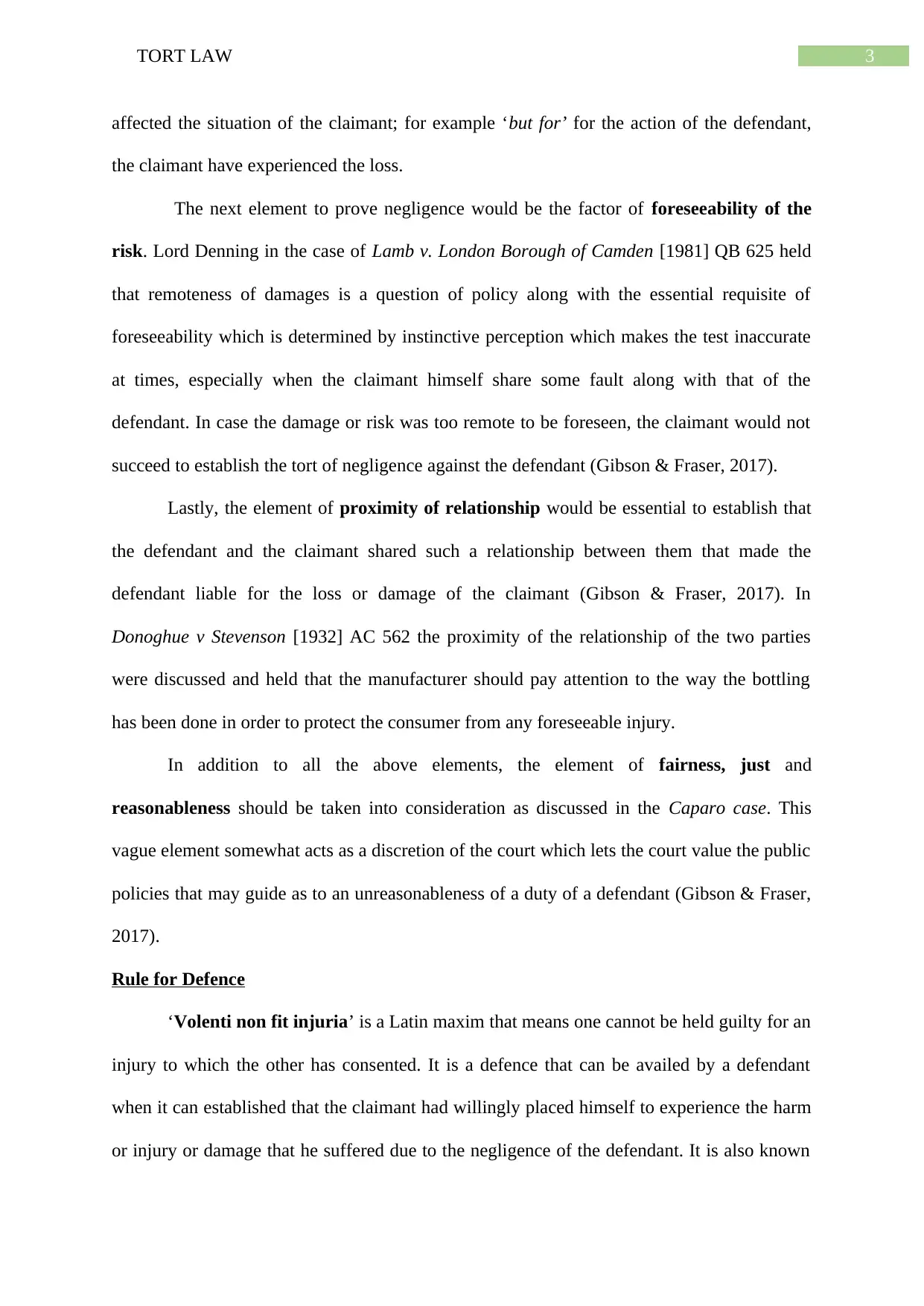
3TORT LAW
affected the situation of the claimant; for example ‘but for’ for the action of the defendant,
the claimant have experienced the loss.
The next element to prove negligence would be the factor of foreseeability of the
risk. Lord Denning in the case of Lamb v. London Borough of Camden [1981] QB 625 held
that remoteness of damages is a question of policy along with the essential requisite of
foreseeability which is determined by instinctive perception which makes the test inaccurate
at times, especially when the claimant himself share some fault along with that of the
defendant. In case the damage or risk was too remote to be foreseen, the claimant would not
succeed to establish the tort of negligence against the defendant (Gibson & Fraser, 2017).
Lastly, the element of proximity of relationship would be essential to establish that
the defendant and the claimant shared such a relationship between them that made the
defendant liable for the loss or damage of the claimant (Gibson & Fraser, 2017). In
Donoghue v Stevenson [1932] AC 562 the proximity of the relationship of the two parties
were discussed and held that the manufacturer should pay attention to the way the bottling
has been done in order to protect the consumer from any foreseeable injury.
In addition to all the above elements, the element of fairness, just and
reasonableness should be taken into consideration as discussed in the Caparo case. This
vague element somewhat acts as a discretion of the court which lets the court value the public
policies that may guide as to an unreasonableness of a duty of a defendant (Gibson & Fraser,
2017).
Rule for Defence
‘Volenti non fit injuria’ is a Latin maxim that means one cannot be held guilty for an
injury to which the other has consented. It is a defence that can be availed by a defendant
when it can established that the claimant had willingly placed himself to experience the harm
or injury or damage that he suffered due to the negligence of the defendant. It is also known
affected the situation of the claimant; for example ‘but for’ for the action of the defendant,
the claimant have experienced the loss.
The next element to prove negligence would be the factor of foreseeability of the
risk. Lord Denning in the case of Lamb v. London Borough of Camden [1981] QB 625 held
that remoteness of damages is a question of policy along with the essential requisite of
foreseeability which is determined by instinctive perception which makes the test inaccurate
at times, especially when the claimant himself share some fault along with that of the
defendant. In case the damage or risk was too remote to be foreseen, the claimant would not
succeed to establish the tort of negligence against the defendant (Gibson & Fraser, 2017).
Lastly, the element of proximity of relationship would be essential to establish that
the defendant and the claimant shared such a relationship between them that made the
defendant liable for the loss or damage of the claimant (Gibson & Fraser, 2017). In
Donoghue v Stevenson [1932] AC 562 the proximity of the relationship of the two parties
were discussed and held that the manufacturer should pay attention to the way the bottling
has been done in order to protect the consumer from any foreseeable injury.
In addition to all the above elements, the element of fairness, just and
reasonableness should be taken into consideration as discussed in the Caparo case. This
vague element somewhat acts as a discretion of the court which lets the court value the public
policies that may guide as to an unreasonableness of a duty of a defendant (Gibson & Fraser,
2017).
Rule for Defence
‘Volenti non fit injuria’ is a Latin maxim that means one cannot be held guilty for an
injury to which the other has consented. It is a defence that can be availed by a defendant
when it can established that the claimant had willingly placed himself to experience the harm
or injury or damage that he suffered due to the negligence of the defendant. It is also known
Secure Best Marks with AI Grader
Need help grading? Try our AI Grader for instant feedback on your assignments.
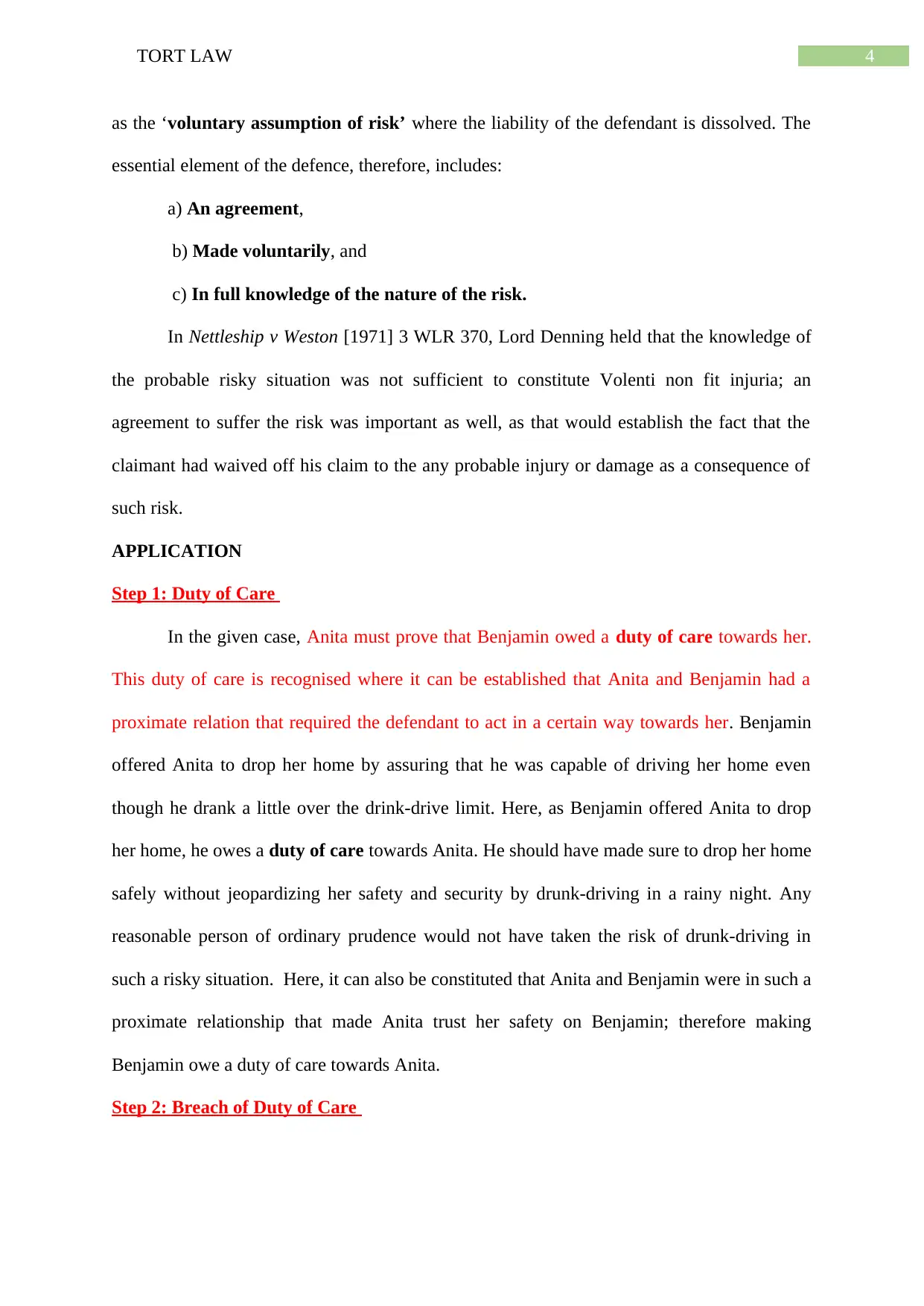
4TORT LAW
as the ‘voluntary assumption of risk’ where the liability of the defendant is dissolved. The
essential element of the defence, therefore, includes:
a) An agreement,
b) Made voluntarily, and
c) In full knowledge of the nature of the risk.
In Nettleship v Weston [1971] 3 WLR 370, Lord Denning held that the knowledge of
the probable risky situation was not sufficient to constitute Volenti non fit injuria; an
agreement to suffer the risk was important as well, as that would establish the fact that the
claimant had waived off his claim to the any probable injury or damage as a consequence of
such risk.
APPLICATION
Step 1: Duty of Care
In the given case, Anita must prove that Benjamin owed a duty of care towards her.
This duty of care is recognised where it can be established that Anita and Benjamin had a
proximate relation that required the defendant to act in a certain way towards her. Benjamin
offered Anita to drop her home by assuring that he was capable of driving her home even
though he drank a little over the drink-drive limit. Here, as Benjamin offered Anita to drop
her home, he owes a duty of care towards Anita. He should have made sure to drop her home
safely without jeopardizing her safety and security by drunk-driving in a rainy night. Any
reasonable person of ordinary prudence would not have taken the risk of drunk-driving in
such a risky situation. Here, it can also be constituted that Anita and Benjamin were in such a
proximate relationship that made Anita trust her safety on Benjamin; therefore making
Benjamin owe a duty of care towards Anita.
Step 2: Breach of Duty of Care
as the ‘voluntary assumption of risk’ where the liability of the defendant is dissolved. The
essential element of the defence, therefore, includes:
a) An agreement,
b) Made voluntarily, and
c) In full knowledge of the nature of the risk.
In Nettleship v Weston [1971] 3 WLR 370, Lord Denning held that the knowledge of
the probable risky situation was not sufficient to constitute Volenti non fit injuria; an
agreement to suffer the risk was important as well, as that would establish the fact that the
claimant had waived off his claim to the any probable injury or damage as a consequence of
such risk.
APPLICATION
Step 1: Duty of Care
In the given case, Anita must prove that Benjamin owed a duty of care towards her.
This duty of care is recognised where it can be established that Anita and Benjamin had a
proximate relation that required the defendant to act in a certain way towards her. Benjamin
offered Anita to drop her home by assuring that he was capable of driving her home even
though he drank a little over the drink-drive limit. Here, as Benjamin offered Anita to drop
her home, he owes a duty of care towards Anita. He should have made sure to drop her home
safely without jeopardizing her safety and security by drunk-driving in a rainy night. Any
reasonable person of ordinary prudence would not have taken the risk of drunk-driving in
such a risky situation. Here, it can also be constituted that Anita and Benjamin were in such a
proximate relationship that made Anita trust her safety on Benjamin; therefore making
Benjamin owe a duty of care towards Anita.
Step 2: Breach of Duty of Care
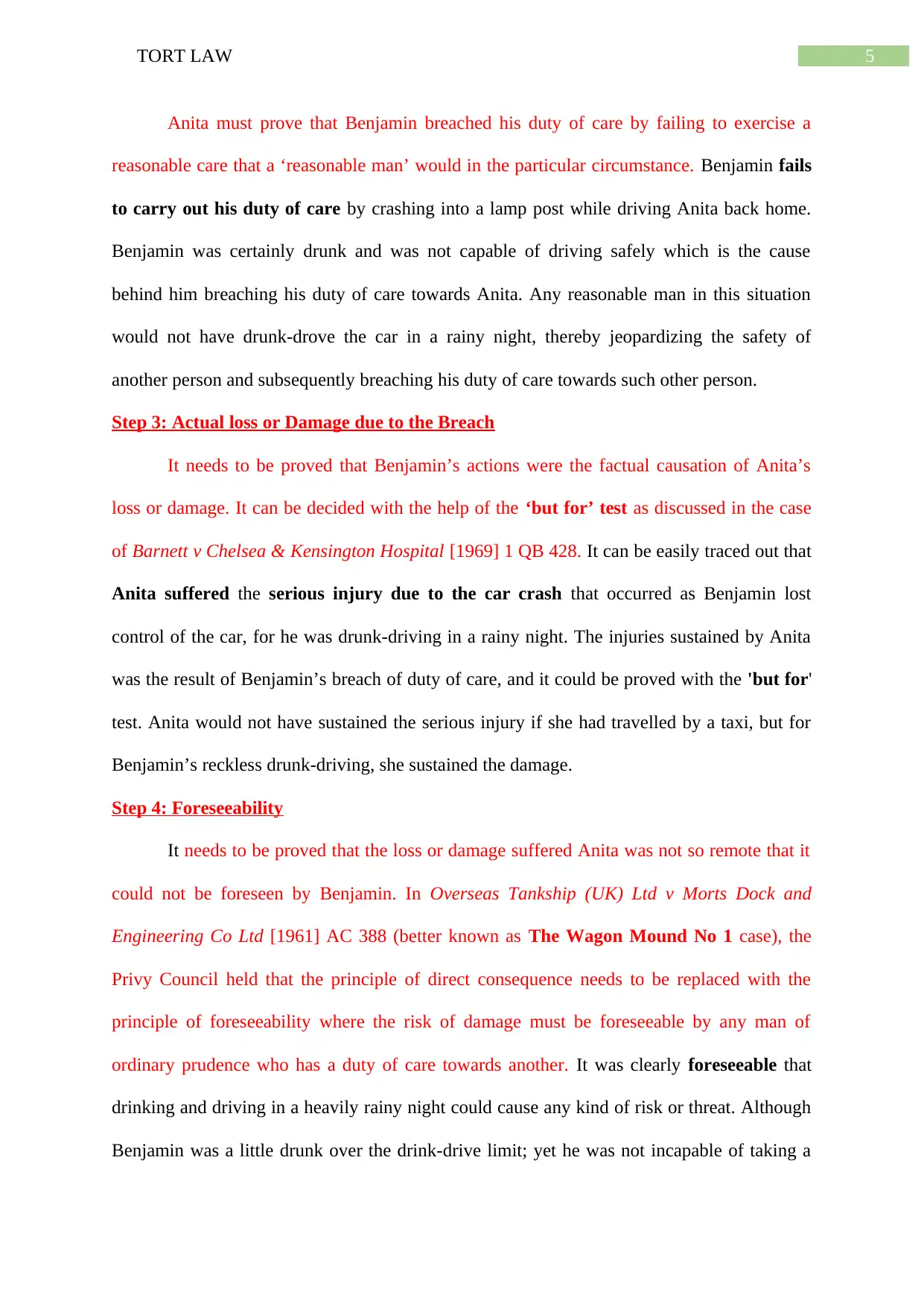
5TORT LAW
Anita must prove that Benjamin breached his duty of care by failing to exercise a
reasonable care that a ‘reasonable man’ would in the particular circumstance. Benjamin fails
to carry out his duty of care by crashing into a lamp post while driving Anita back home.
Benjamin was certainly drunk and was not capable of driving safely which is the cause
behind him breaching his duty of care towards Anita. Any reasonable man in this situation
would not have drunk-drove the car in a rainy night, thereby jeopardizing the safety of
another person and subsequently breaching his duty of care towards such other person.
Step 3: Actual loss or Damage due to the Breach
It needs to be proved that Benjamin’s actions were the factual causation of Anita’s
loss or damage. It can be decided with the help of the ‘but for’ test as discussed in the case
of Barnett v Chelsea & Kensington Hospital [1969] 1 QB 428. It can be easily traced out that
Anita suffered the serious injury due to the car crash that occurred as Benjamin lost
control of the car, for he was drunk-driving in a rainy night. The injuries sustained by Anita
was the result of Benjamin’s breach of duty of care, and it could be proved with the 'but for'
test. Anita would not have sustained the serious injury if she had travelled by a taxi, but for
Benjamin’s reckless drunk-driving, she sustained the damage.
Step 4: Foreseeability
It needs to be proved that the loss or damage suffered Anita was not so remote that it
could not be foreseen by Benjamin. In Overseas Tankship (UK) Ltd v Morts Dock and
Engineering Co Ltd [1961] AC 388 (better known as The Wagon Mound No 1 case), the
Privy Council held that the principle of direct consequence needs to be replaced with the
principle of foreseeability where the risk of damage must be foreseeable by any man of
ordinary prudence who has a duty of care towards another. It was clearly foreseeable that
drinking and driving in a heavily rainy night could cause any kind of risk or threat. Although
Benjamin was a little drunk over the drink-drive limit; yet he was not incapable of taking a
Anita must prove that Benjamin breached his duty of care by failing to exercise a
reasonable care that a ‘reasonable man’ would in the particular circumstance. Benjamin fails
to carry out his duty of care by crashing into a lamp post while driving Anita back home.
Benjamin was certainly drunk and was not capable of driving safely which is the cause
behind him breaching his duty of care towards Anita. Any reasonable man in this situation
would not have drunk-drove the car in a rainy night, thereby jeopardizing the safety of
another person and subsequently breaching his duty of care towards such other person.
Step 3: Actual loss or Damage due to the Breach
It needs to be proved that Benjamin’s actions were the factual causation of Anita’s
loss or damage. It can be decided with the help of the ‘but for’ test as discussed in the case
of Barnett v Chelsea & Kensington Hospital [1969] 1 QB 428. It can be easily traced out that
Anita suffered the serious injury due to the car crash that occurred as Benjamin lost
control of the car, for he was drunk-driving in a rainy night. The injuries sustained by Anita
was the result of Benjamin’s breach of duty of care, and it could be proved with the 'but for'
test. Anita would not have sustained the serious injury if she had travelled by a taxi, but for
Benjamin’s reckless drunk-driving, she sustained the damage.
Step 4: Foreseeability
It needs to be proved that the loss or damage suffered Anita was not so remote that it
could not be foreseen by Benjamin. In Overseas Tankship (UK) Ltd v Morts Dock and
Engineering Co Ltd [1961] AC 388 (better known as The Wagon Mound No 1 case), the
Privy Council held that the principle of direct consequence needs to be replaced with the
principle of foreseeability where the risk of damage must be foreseeable by any man of
ordinary prudence who has a duty of care towards another. It was clearly foreseeable that
drinking and driving in a heavily rainy night could cause any kind of risk or threat. Although
Benjamin was a little drunk over the drink-drive limit; yet he was not incapable of taking a
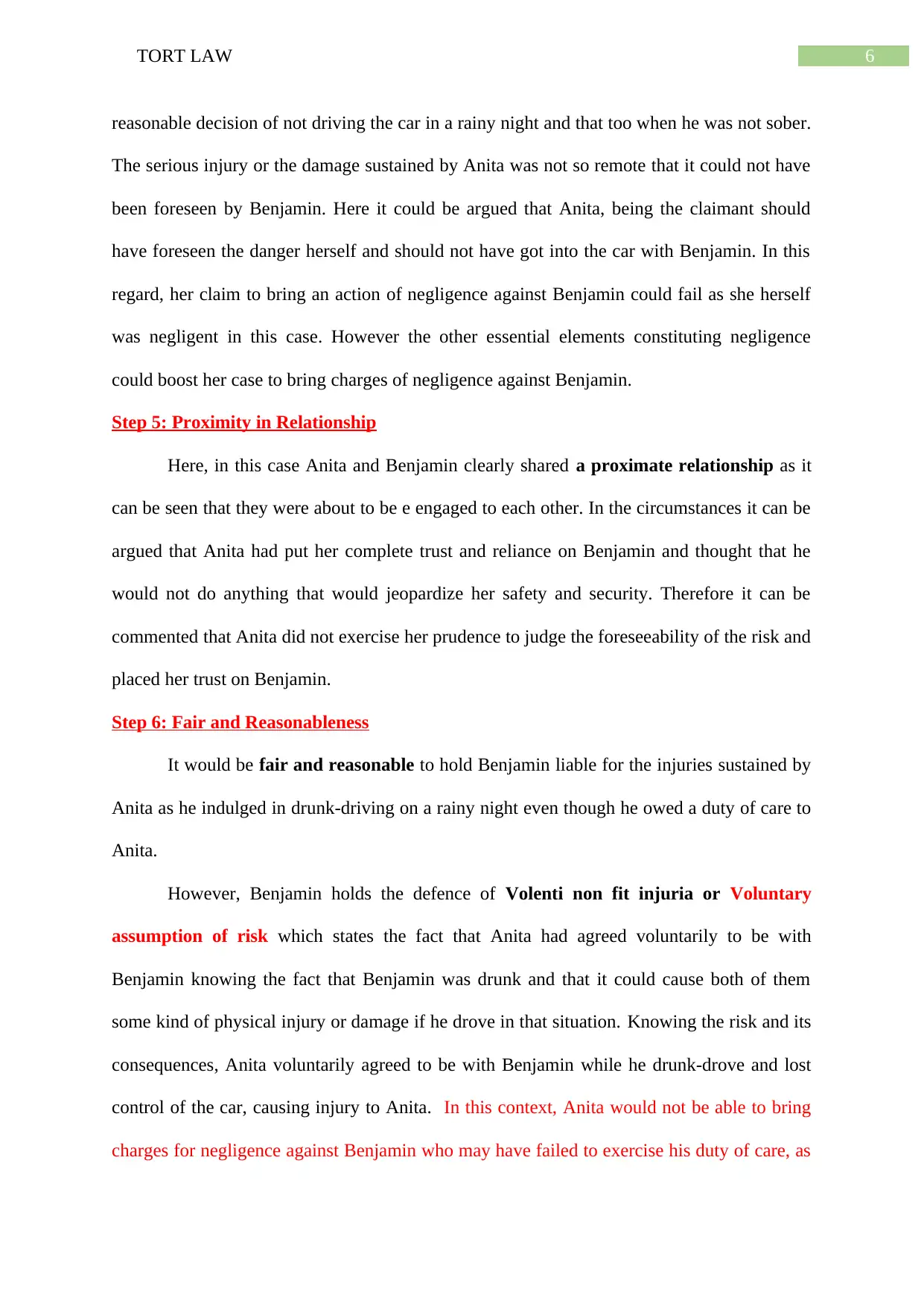
6TORT LAW
reasonable decision of not driving the car in a rainy night and that too when he was not sober.
The serious injury or the damage sustained by Anita was not so remote that it could not have
been foreseen by Benjamin. Here it could be argued that Anita, being the claimant should
have foreseen the danger herself and should not have got into the car with Benjamin. In this
regard, her claim to bring an action of negligence against Benjamin could fail as she herself
was negligent in this case. However the other essential elements constituting negligence
could boost her case to bring charges of negligence against Benjamin.
Step 5: Proximity in Relationship
Here, in this case Anita and Benjamin clearly shared a proximate relationship as it
can be seen that they were about to be e engaged to each other. In the circumstances it can be
argued that Anita had put her complete trust and reliance on Benjamin and thought that he
would not do anything that would jeopardize her safety and security. Therefore it can be
commented that Anita did not exercise her prudence to judge the foreseeability of the risk and
placed her trust on Benjamin.
Step 6: Fair and Reasonableness
It would be fair and reasonable to hold Benjamin liable for the injuries sustained by
Anita as he indulged in drunk-driving on a rainy night even though he owed a duty of care to
Anita.
However, Benjamin holds the defence of Volenti non fit injuria or Voluntary
assumption of risk which states the fact that Anita had agreed voluntarily to be with
Benjamin knowing the fact that Benjamin was drunk and that it could cause both of them
some kind of physical injury or damage if he drove in that situation. Knowing the risk and its
consequences, Anita voluntarily agreed to be with Benjamin while he drunk-drove and lost
control of the car, causing injury to Anita. In this context, Anita would not be able to bring
charges for negligence against Benjamin who may have failed to exercise his duty of care, as
reasonable decision of not driving the car in a rainy night and that too when he was not sober.
The serious injury or the damage sustained by Anita was not so remote that it could not have
been foreseen by Benjamin. Here it could be argued that Anita, being the claimant should
have foreseen the danger herself and should not have got into the car with Benjamin. In this
regard, her claim to bring an action of negligence against Benjamin could fail as she herself
was negligent in this case. However the other essential elements constituting negligence
could boost her case to bring charges of negligence against Benjamin.
Step 5: Proximity in Relationship
Here, in this case Anita and Benjamin clearly shared a proximate relationship as it
can be seen that they were about to be e engaged to each other. In the circumstances it can be
argued that Anita had put her complete trust and reliance on Benjamin and thought that he
would not do anything that would jeopardize her safety and security. Therefore it can be
commented that Anita did not exercise her prudence to judge the foreseeability of the risk and
placed her trust on Benjamin.
Step 6: Fair and Reasonableness
It would be fair and reasonable to hold Benjamin liable for the injuries sustained by
Anita as he indulged in drunk-driving on a rainy night even though he owed a duty of care to
Anita.
However, Benjamin holds the defence of Volenti non fit injuria or Voluntary
assumption of risk which states the fact that Anita had agreed voluntarily to be with
Benjamin knowing the fact that Benjamin was drunk and that it could cause both of them
some kind of physical injury or damage if he drove in that situation. Knowing the risk and its
consequences, Anita voluntarily agreed to be with Benjamin while he drunk-drove and lost
control of the car, causing injury to Anita. In this context, Anita would not be able to bring
charges for negligence against Benjamin who may have failed to exercise his duty of care, as
Paraphrase This Document
Need a fresh take? Get an instant paraphrase of this document with our AI Paraphraser
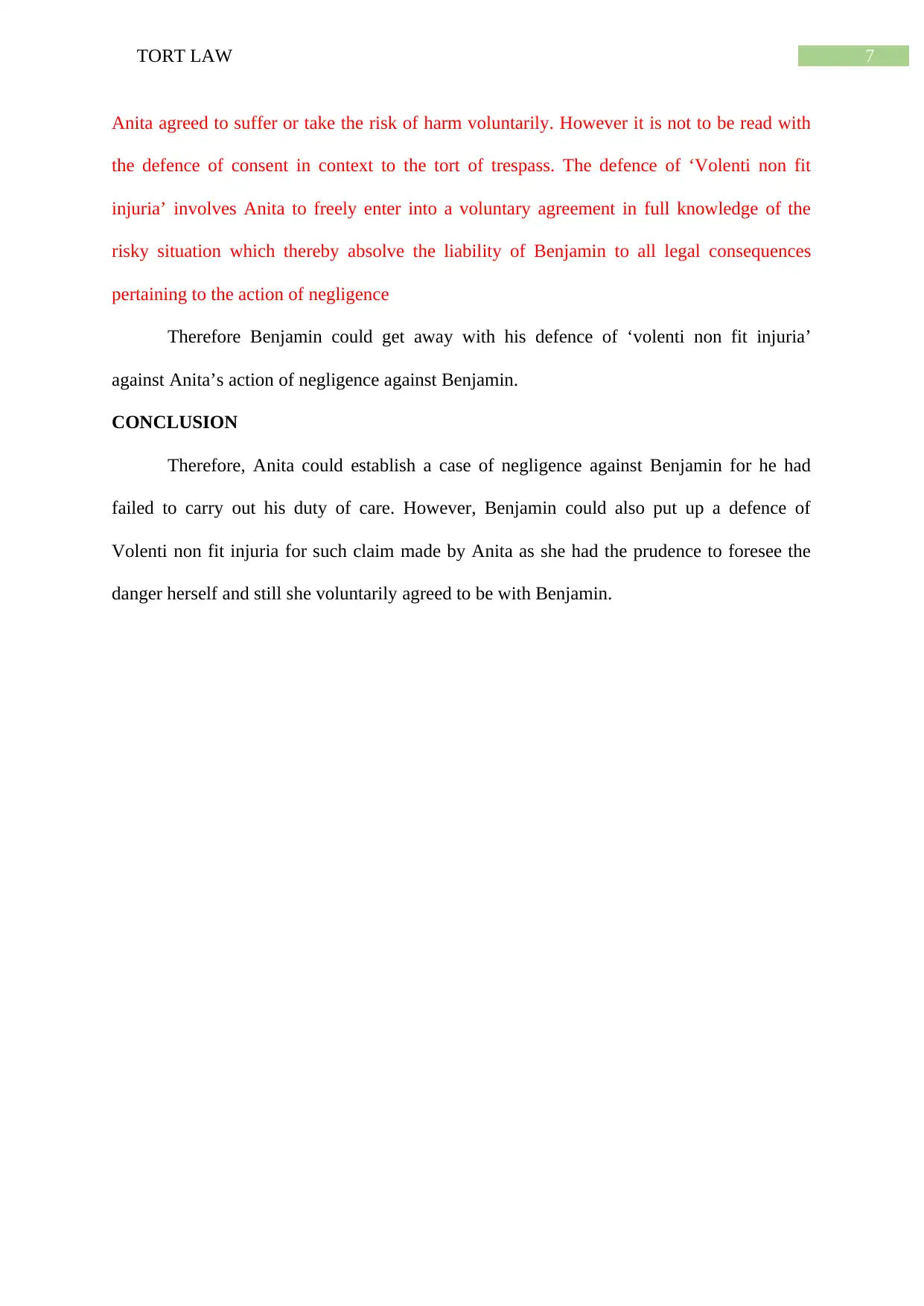
7TORT LAW
Anita agreed to suffer or take the risk of harm voluntarily. However it is not to be read with
the defence of consent in context to the tort of trespass. The defence of ‘Volenti non fit
injuria’ involves Anita to freely enter into a voluntary agreement in full knowledge of the
risky situation which thereby absolve the liability of Benjamin to all legal consequences
pertaining to the action of negligence
Therefore Benjamin could get away with his defence of ‘volenti non fit injuria’
against Anita’s action of negligence against Benjamin.
CONCLUSION
Therefore, Anita could establish a case of negligence against Benjamin for he had
failed to carry out his duty of care. However, Benjamin could also put up a defence of
Volenti non fit injuria for such claim made by Anita as she had the prudence to foresee the
danger herself and still she voluntarily agreed to be with Benjamin.
Anita agreed to suffer or take the risk of harm voluntarily. However it is not to be read with
the defence of consent in context to the tort of trespass. The defence of ‘Volenti non fit
injuria’ involves Anita to freely enter into a voluntary agreement in full knowledge of the
risky situation which thereby absolve the liability of Benjamin to all legal consequences
pertaining to the action of negligence
Therefore Benjamin could get away with his defence of ‘volenti non fit injuria’
against Anita’s action of negligence against Benjamin.
CONCLUSION
Therefore, Anita could establish a case of negligence against Benjamin for he had
failed to carry out his duty of care. However, Benjamin could also put up a defence of
Volenti non fit injuria for such claim made by Anita as she had the prudence to foresee the
danger herself and still she voluntarily agreed to be with Benjamin.
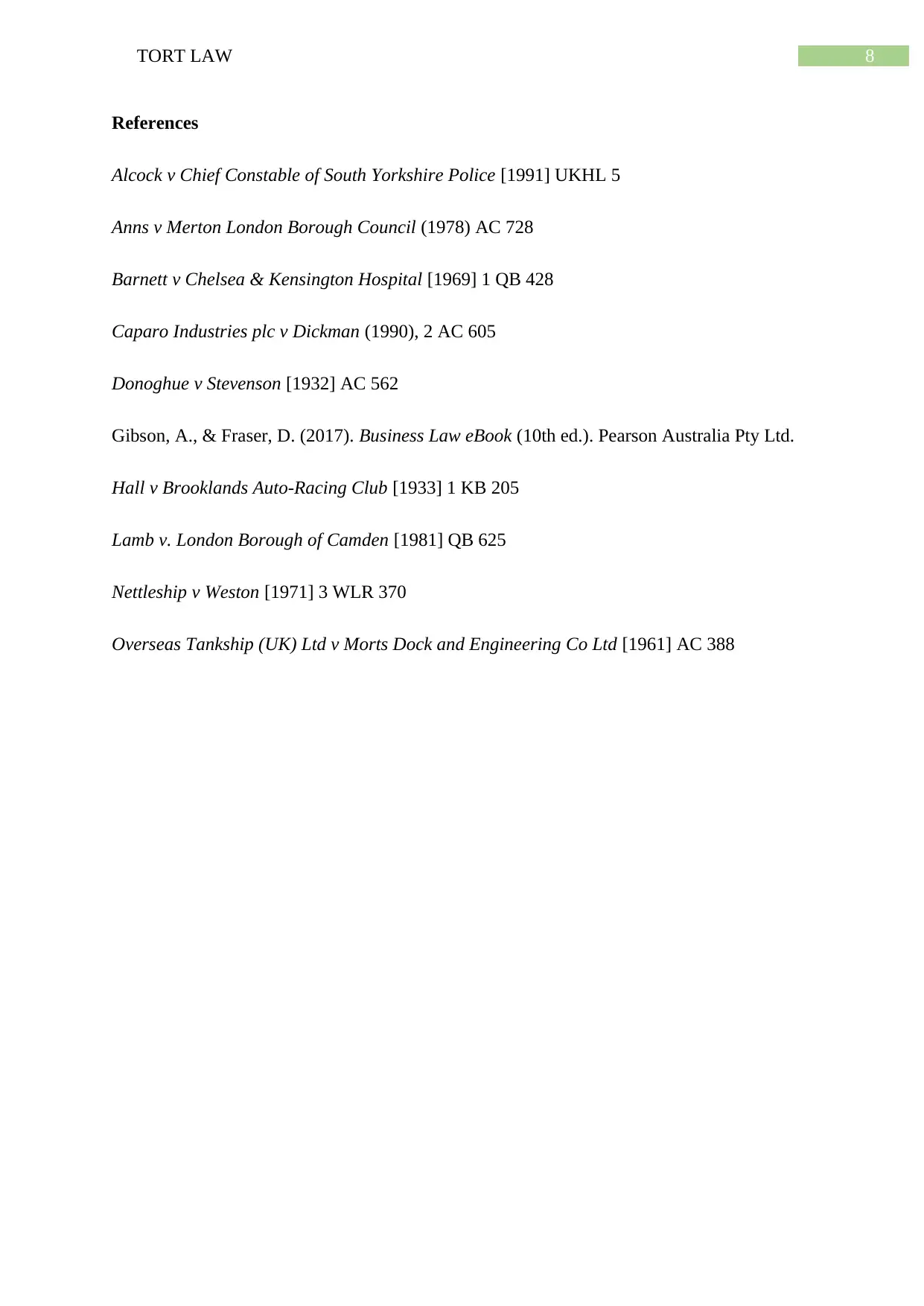
8TORT LAW
References
Alcock v Chief Constable of South Yorkshire Police [1991] UKHL 5
Anns v Merton London Borough Council (1978) AC 728
Barnett v Chelsea & Kensington Hospital [1969] 1 QB 428
Caparo Industries plc v Dickman (1990), 2 AC 605
Donoghue v Stevenson [1932] AC 562
Gibson, A., & Fraser, D. (2017). Business Law eBook (10th ed.). Pearson Australia Pty Ltd.
Hall v Brooklands Auto-Racing Club [1933] 1 KB 205
Lamb v. London Borough of Camden [1981] QB 625
Nettleship v Weston [1971] 3 WLR 370
Overseas Tankship (UK) Ltd v Morts Dock and Engineering Co Ltd [1961] AC 388
References
Alcock v Chief Constable of South Yorkshire Police [1991] UKHL 5
Anns v Merton London Borough Council (1978) AC 728
Barnett v Chelsea & Kensington Hospital [1969] 1 QB 428
Caparo Industries plc v Dickman (1990), 2 AC 605
Donoghue v Stevenson [1932] AC 562
Gibson, A., & Fraser, D. (2017). Business Law eBook (10th ed.). Pearson Australia Pty Ltd.
Hall v Brooklands Auto-Racing Club [1933] 1 KB 205
Lamb v. London Borough of Camden [1981] QB 625
Nettleship v Weston [1971] 3 WLR 370
Overseas Tankship (UK) Ltd v Morts Dock and Engineering Co Ltd [1961] AC 388
1 out of 9
Related Documents
Your All-in-One AI-Powered Toolkit for Academic Success.
+13062052269
info@desklib.com
Available 24*7 on WhatsApp / Email
![[object Object]](/_next/static/media/star-bottom.7253800d.svg)
Unlock your academic potential
© 2024 | Zucol Services PVT LTD | All rights reserved.





